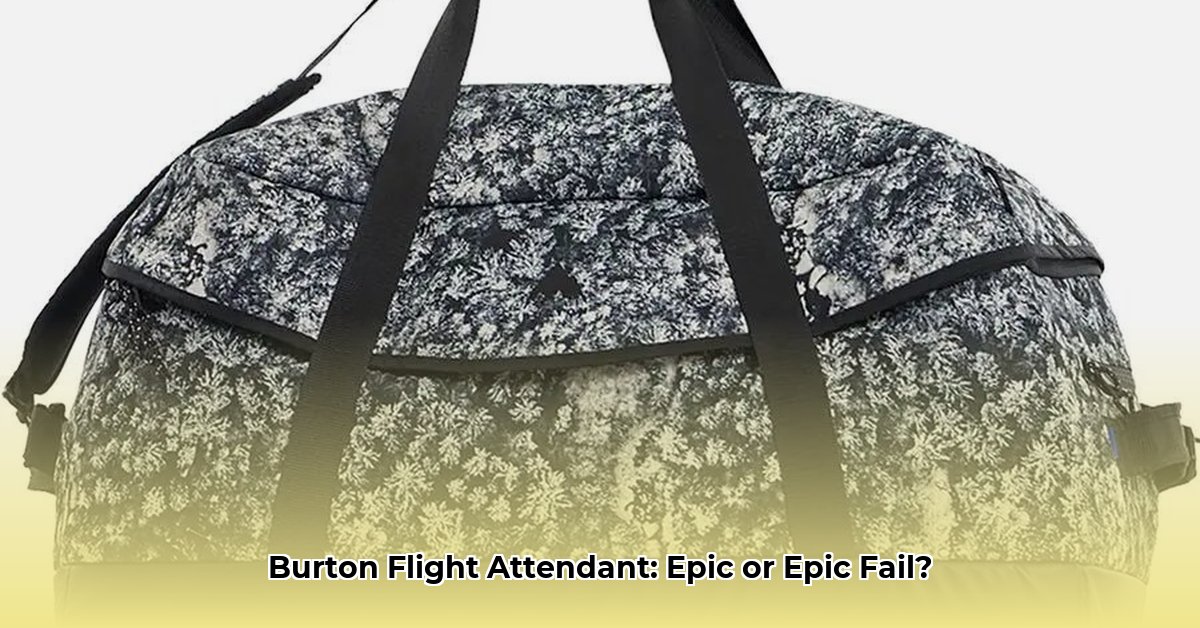Considering a snowboard upgrade? The Burton Flight Attendant caters to seasoned riders aiming for high-performance on challenging terrain. This review uncovers tech specs, performance across conditions, and competitor comparisons to aid your decision. Is the Flight Attendant the right board for conquering any mountain? Let’s find out!
Burton Flight Attendant: Expert Freeride Snowboard Analysis
The Burton Flight Attendant isn’t for beginners; it’s a serious board for experienced riders who crave performance. It demands respect and skill on the slopes, making it an excellent choice for those tackling challenging terrain. This board offers a unique blend of carving precision and powder prowess.
Unpacking the Tech: Advanced Snowboard Features
The Flight Attendant boasts impressive technology designed for optimal performance.
- The Super Fly II core utilizes stronger and lighter woods in specific areas to provide pop, strength, and reduced weight. This core balances responsiveness and stability, providing a lively feel for carving and steadiness at high speeds.
- The Sintered WFO base infuses a specially formulated wax deep into the pores of the high-density sintered material, ensuring durability and speed, essential for long mountain descents and varied snow conditions.
- Directional camber – Entry rocker causes the nose to lift while camber under both feet maintains momentum and stability through turns and variable conditions. This enhances edge grip, enabling powerful turns. The early rise in the nose aids float in powder, while the tapered shape boosts maneuverability.
- Carbon I-Beam – An ultra-light carbon backbone that increases pop and longitudinal snap.
- Balanced Freeride Geometry – Balanced Freeride Geometry spec setback camber and a sidecut that is centered on your stance to create a twin freestyle feel when riding flat base. On edge it turns tight and quick with the float and prowess expected from a directional deck.
How It Rides: Performance Across Snow Conditions
Here’s how the Flight Attendant performs in various conditions:
Powder Days: The directional shape and rockered nose provide excellent float and responsiveness in deep powder, making powder runs exhilarating. The board planes easily, maintaining speed and control in the softest snow.
Carving: The board truly shines here, offering amazing edge hold and responsiveness. The stiff flex and camber profile translate to exceptional control and confidence, making it feel like an extension of your body when laying down hard carves on groomers.
Hardpack & Ice: While decent, it lacks the specialized grip of boards specifically designed for icy conditions. Proper waxing with a wax formulated for cold temperatures and sharp edge tuning can help mitigate this. You may need to adjust your speed and use deliberate, precise movements.
Park & Jumps: While not primarily designed as a park board, the Flight Attendant’s stiffness and pop make it suitable for larger jumps and more powerful approaches, offering stable landings. However, its directional shape and stiffness make playful jibbing and technical tricks less ideal.
The Good, the Bad, and the Ugly: A Balanced Snowboard Perspective
Here’s a balanced look at the pros and cons:
Pros:
- Unmatched Carving Performance: It’s a true carver’s dream on groomed runs and hardpack.
- Exceptional Powder Float: Glides effortlessly in deep snow, maintaining excellent control.
- Powerful Pop for Big Jumps: Delivers serious airtime and stable landings.
- Durable Construction: Built to withstand the rigors of aggressive riding, ensuring longevity for many seasons.
- Versatile All-Mountain Capabilities: Handles diverse snow conditions well, making it a solid choice for riders who explore the entire mountain.
Cons:
- Limited Hardpack/Ice Grip: Requires careful technique, edge maintenance, and appropriate waxing for optimal performance on icy surfaces.
- Not Ideal for Park Riding: Its stiffness and directional shape make it less suited for playful tricks and jibbing in the terrain park.
- Stiff Flex: Demanding and may be too much for less experienced or lighter riders who prefer a more forgiving board.
- Higher Price Point: Its advanced technology and high-performance design come at a premium cost.
- Less Responsive at Slower Speeds: Designed for speed and aggressive riding, it may feel less lively at slower, more mellow paces.
Who Should Buy This Board? Sizing Up the Ideal Snowboarder.
The Burton Flight Attendant isn’t for beginners. It is best suited for advanced and expert riders with solid skills, who are comfortable with a stiff flex and a directional board. If you prioritize carving performance and powder prowess and are a confident, aggressive rider, this board is an excellent choice. Consider your weight and boot size when selecting the appropriate length.
The Competition: Examining Snowboard Alternatives
The Flight Attendant competes with other high-performance freeride boards such as the Jones Flagship, Arbor Wasteland, and Lib Tech T. Rice Pro. While the Flight Attendant excels in powder and carving, other boards might offer better performance in specific conditions, such as icy hardpack or park riding. Base your choice on your individual riding style, terrain preferences, and desired performance priorities.
Mitigating Risks: Snowboard Safety Considerations
Be aware of potential issues and how to address them for a safer and more enjoyable riding experience.
| Risk Factor | Potential Issue | Mitigation Strategy |
|---|---|---|
| Stiff Flex | Difficulty for intermediate riders | Consider other boards with a softer flex or demo the Flight Attendant first to assess its suitability. |
| Hardpack Performance | Reduced grip | Regular waxing, edge tuning, and adaptive riding techniques, such as maintaining a centered stance and adjusting edge angle. |
| High Price Point | Financial burden | Research sales, consider purchasing during off-season, or explore used options in good condition. Budget carefully. |
| Speed & Stability | Can feel sluggish at low speeds | Be aware that the board is designed for speed. |
Final Thoughts: The Burton Flight Attendant is a high-performance snowboard with notable strengths and weaknesses. It is best suited for skilled, aggressive riders who prioritize carving and powder performance and who are comfortable with a stiff, responsive board. If that describes you, the Flight Attendant could be an incredible addition to your quiver. Otherwise, explore other options that are better suited to your skill level, riding style, and terrain preferences.
How to improve Burton Flight Attendant hardpack performance
Key Takeaways:
- The Burton Flight Attendant requires specific techniques and diligent maintenance for optimal hardpack performance.
- Proper edge tuning and waxing are essential to maximize grip on hardpack and icy surfaces.
- Rider skill and technique play a crucial role in enhancing hardpack performance.
- Understanding the board’s directional camber profile aids in adapting your riding style for hardpack conditions.
Technical Deep Dive: Flight Attendant Snowboard Features
The Flight Attendant features a directional camber profile, specifically designed for freeride performance. This profile provides excellent edge hold, requiring a specific riding style and technique to fully utilize its capabilities on hardpack. The tapered shape enhances float in powder, but on hardpack, precise technique and board preparation are key. The Sintered WFO base is fast and durable, but requires regular maintenance, including waxing, to maintain optimal glide and control.
On-Snow Performance: Hardpack Improvement Tips
How do you improve the Burton Flight Attendant’s hardpack performance?
- Edge Tuning: Sharp edges are essential for improved grip on hardpack and icy conditions. A professional tune, or regular at-home maintenance with an edge tuning tool, is highly recommended to maintain optimal edge sharpness.
- Waxing: Use a wax specifically formulated for cold temperatures and hardpack or icy conditions. Applying wax regularly reduces friction and significantly improves control and glide.
- Technique Refinement: The rider’s stance and edge angle are paramount for effective hardpack riding. Maintain a centered stance over the board, engage your core for stability, and control turns by shifting your body weight and applying subtle pressure to the edges. Adjust your edge angle to find the sweet spot for maximum grip.
- Speed Management: Maintain consistent speed and avoid abrupt speed variations, which can cause the board to lose its edge and become unstable. Focus on smooth transitions between turns.
- Board Preparation: Regularly inspect and clean the base of the board to ensure that wax adheres properly and that there are no imperfections that could impede performance.
Pros and Cons – A Balanced View:
| Pros | Cons |
|---|---|
| Versatile all-mountain performance | Less responsive on hardpack than dedicated carving boards |
| Excellent float in powder | Requires significant technique adjustments on hardpack |
| Agile and maneuverable | Maintenance (tuning/waxing) is crucial for optimal hardpack performance |
Who Should Ride the Flight Attendant?
Intermediate to advanced riders who value versatility and are willing to invest time in board maintenance and technique refinement will appreciate the Flight Attendant. It is not an ideal choice for hardpack specialists who primarily ride in icy conditions or prioritize carving above all else.
Burton Flight Attendant Snowboard Review: Mastering Deep Powder Performance
Key Takeaways:
- The Burton Flight Attendant offers exceptional powder performance due to its rockered nose and directional shape.
- It delivers powerful carving and high-speed stability thanks to its stiff flex and directional
- Lyrics Competition Offers Prizes And Valuable Industry Feedback - December 15, 2025
- Major Lyric Contest Opens Doors for Aspiring Songwriters - December 14, 2025
- American Song Contest 2025 Invites Songwriters To Impress Industry Experts - December 13, 2025










